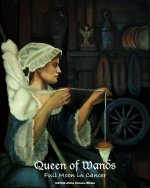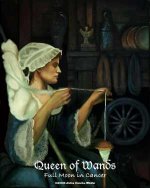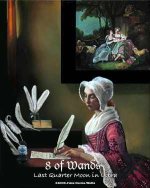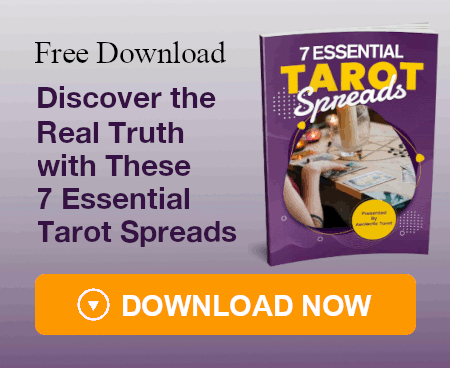greycats
Traditionally, the Queen of Wands is organized and energetic. She runs things: a queen bee. She’s the picture of sunny openness until one notices the lions supporting her throne (a characteristic of Cybele and other powerful earth goddesses) and, of course, the black cat. The presence of that black cat would have made her eligible for witchhood once upon a time. The Queen of Wands is a lady of parts, even in RWS.
In the Maat, she continues to be interesting. She’s taken up spinning, a task quite fitted to her on all levels. Wands is the handicraft suit, except for gardening, and as Queen, she epitomizes the ideal spinner who was in ancient times Athena, Minerva, Freya, et al. The art of taking bits of fluff and creating a garment from them must have seemed magical in the days before much history was written down. Think what one can do with a big stick and a weighted top. Magic, indeed. The black cat has reason to be interested.
The black cat has reason to be interested.
So the Queen very much “in her element” wears an elegant blue dress edged with braid and trimmed with fine lace. Her surroundings are somewhat humbler, however. She appears to be queen of a cabin, though a very well made one. The fireplace mantle to her left supports some of her earlier work, as well as a pierced work lantern, some plates, a box and another object (statuette?). A fireplace bellows hangs on the wall.
Most interestingly, between the spinner and the fireplace, sits a spinning wheel, unused. A spinning wheel is a lot more efficient if one wants to turn out sufficient yarn to cloth the family. It’s even more flexible in some ways than using the distaff and spindle. So why not use it? I can think of a couple of reasons (other than for purposes of illustration) that someone might revert to the older method of spinning thread/yarn. But, I’d like to hear other opinions. Why do you think she’s using the spindle and distaff rather than the spinning wheel?
A couple of other bits to weave in: we have one more arcana in this lunar cycle which features the family with emphasis on the mother/mother-child elements. For millennia, weaving has been the quintessential womanly household task. In fact, even now one hears phrases like "the distaff side" mentioned when someone means a mother's kin, or her work, or her areas of interest. Weaving also mimics birth in this way: one begins with "nothing," specks of tissue or fiber, and over time creates from this nothingness something, a child, a shirt. Finally, weaving has to do with the daily round. In mythology, the sisters weave our lives out of our days and our actions. With parents and children, the same thing happens: we turn and touch each other across the days, weaving patterns of dinners, vacations, jokes and bedtimes that become "family."
In the Maat, she continues to be interesting. She’s taken up spinning, a task quite fitted to her on all levels. Wands is the handicraft suit, except for gardening, and as Queen, she epitomizes the ideal spinner who was in ancient times Athena, Minerva, Freya, et al. The art of taking bits of fluff and creating a garment from them must have seemed magical in the days before much history was written down. Think what one can do with a big stick and a weighted top. Magic, indeed.
So the Queen very much “in her element” wears an elegant blue dress edged with braid and trimmed with fine lace. Her surroundings are somewhat humbler, however. She appears to be queen of a cabin, though a very well made one. The fireplace mantle to her left supports some of her earlier work, as well as a pierced work lantern, some plates, a box and another object (statuette?). A fireplace bellows hangs on the wall.
Most interestingly, between the spinner and the fireplace, sits a spinning wheel, unused. A spinning wheel is a lot more efficient if one wants to turn out sufficient yarn to cloth the family. It’s even more flexible in some ways than using the distaff and spindle. So why not use it? I can think of a couple of reasons (other than for purposes of illustration) that someone might revert to the older method of spinning thread/yarn. But, I’d like to hear other opinions. Why do you think she’s using the spindle and distaff rather than the spinning wheel?

A couple of other bits to weave in: we have one more arcana in this lunar cycle which features the family with emphasis on the mother/mother-child elements. For millennia, weaving has been the quintessential womanly household task. In fact, even now one hears phrases like "the distaff side" mentioned when someone means a mother's kin, or her work, or her areas of interest. Weaving also mimics birth in this way: one begins with "nothing," specks of tissue or fiber, and over time creates from this nothingness something, a child, a shirt. Finally, weaving has to do with the daily round. In mythology, the sisters weave our lives out of our days and our actions. With parents and children, the same thing happens: we turn and touch each other across the days, weaving patterns of dinners, vacations, jokes and bedtimes that become "family."




